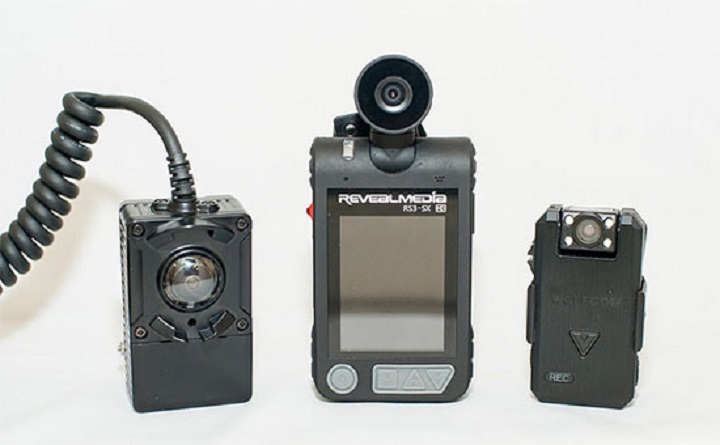WATCH ABOVE: Toronto police detail plans for body camera test run. Pilot project begins in 55 Division next week. Mark Carcasole reports.

TORONTO – On May 18, Toronto police will launch a pilot project to test-run the use of body-worn cameras on a select number of officers on active duty.
The test period will last one year, at which point a review will be conducted to evaluate the results.
“We’re looking to create the most accurate account of an interaction between an officer and a citizen,” said Staff Superintendent Tom Russell.
“We’re looking to enhance public trust and our own police legitimacy in the eyes of the community.”
The use body-worn cameras was one of the recommendations put forth by former Supreme Court of Canada justice Frank Iacobucci in a sweeping review of the Toronto Police Service’s guidelines and practices.
Toronto police Chief Bill Blair commissioned the report in 2013 after the police shooting death of teenager Sammy Yatim on an empty streetcar.
The incident sparked a public outcry over police use of force.
During the test period, police will be handing out over 20,000 survey packages to randomly selected homes and businesses for feedback.
WATCH ABOVE: Staff Superintendent Tom Russell confirmed Friday that new body cameras worn by officers will be activated on every call or investigation.

Get daily National news
At the end of the trial phase, recommendations will be forwarded to Chief Mark Saunders.
READ MORE: Canada’s privacy watchdogs flag concerns over police body cameras
Toronto police have selected three different types of cameras to test with the cost of the pilot project estimated at $500,000.
Staff Supt. Russell said officers have been trained to follow procedure and to turn the cameras on during service calls and emergency situations.
“If there is an allegation that a procedure has not been followed, the officer could be subject to the discipline process,” he said.
“The officers will not be activating the camera and simply walk into the community, surveilling people and later looking at the video and saying, ‘Who’s associating with who?’.”
WATCH ABOVE: Staff Superintendent Tom Russell explains that the police wearing the body cameras do not have the ability to delete or manipulate the footage.
“We’re not looking to record casual or informal conversations with people.”
Sukanya Pillay, executive director for the Canadian Civil Liberties Association, said police must be transparent with the public over the cameras.
“I think in general police-worn body cameras can be a useful tool to ensure police accountability,” said Pillay. “They’re also though, a potential tool to invade privacy. So really we have to make sure that we get the dynamic right.”
Who will have access to footage is a key question.
“Who keeps this footage, when are the cameras on, what is the protocol for when the cameras get turned off, what about editing along the way, what about usage — meaning where will this footage reside?”
- Residents allowed back into one of two Thorncliffe Park condos evacuated due to fire
- Despite hosting Taylor Swift, Toronto collected less revenue than feds, province: report
- Some school buses cancelled in GTA as region braces for freezing rain
- Ford will file appeal against court ruling to release personal phone records
She suggested the cameras might act as a deterrent — people won’t want to call police because they don’t want to be on camera.
Protocol surrounding video surveillance that can be turned on and off raises serious questions. Pillay said it could have a negative impact on police if a camera is off when a significant incident occurs.
“How is that discretion being exercised?” said Pillay. “We’d rather err on the side of capturing that information.”
5 Things To Know
1. What Units/Divisions are participating in the pilot project?
100 officers have been pre-selected from the TAVIS Rapid Response Teams, Traffic Services, 55 Division Primary Response Unit and 43 Division Community Response Unit.
WATCH ABOVE: Staff Superintendent Tom Russell explains that it is possible to attain footage from body cams via the Toronto police website.
2. When will the body-worn camera be turned on and turned off?
A police officer will turn on the body-worn camera prior to arriving at a call for service or when they start investigating an individual or incident. A police officer will turn off the body-worn camera when the call for service or investigation is complete or when the officer determines that continuous recording is no longer serving its intended purpose.
3. When can a member of the public ask for the body-worn camera to be turned off?
The only time a request to turn off a body-worn camera will be allowed is when a police officer has been given permission to enter a private home and the person granting permission has made the request. This can happen either before the officer enters the private home or at any time during the officer’s presence in the private home.
WATCH ABOVE: Staff Superintendent Tom Russell gives insight regarding the storage time frame of body cam footage worn by police.
4. How long will the body-worn camera data be stored?
Data will be stored for a minimum of one year unless there is a reason to retain it longer, such as for court purposes or an ongoing investigation.
5. Where will the body-worn camera data be stored?
The data will be encrypted and stored on a secure server owned and operated by the Toronto Police Service.








Comments